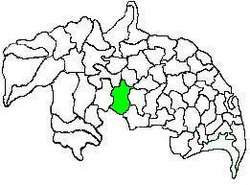Narasaraopet mandal
Narasaraopet mandal is one of the 57 mandals in Guntur district of the India state of Andhra Pradesh. It is under the administration of Narasaraopet revenue division and the headquarters are located at Narasaraopet city.[2][3] The mandal is bounded by Rompicherla, Nekarikallu, Muppalla, Phirangipuram, Nadendla and Chilakaluripeta. It also borders Prakasam district.[4]
Narasaraopet mandal | |
|---|---|
 Mandal map of Guntur district showing Narasaraopet mandal (in green) | |
.svg.png) Narasaraopet mandal Location in Andhra Pradesh, India | |
| Coordinates: 16°14′34″N 80°38′24″E | |
| Country | India |
| State | Andhra Pradesh |
| District | Guntur |
| Headquarters | Narasaraopet |
| Government | |
| • Body | Mandal Parishad |
| • Tehsildar | M.Leela Sanjeeva Kumari |
| Population (2011)[1] | |
| • Total | 211,948 |
| Languages | |
| • Official | Telugu |
| Time zone | UTC+5:30 (IST) |
Demographics
As of 2011 census, the mandal had a population of 211,948. The total population constitute, 106,926 males and 105,022 females —a sex ratio of 982 females per 1000 males. 21,370 children are in the age group of 0–6 years, of which 10,953 are boys and 10,417 are girls —a ratio of 951 per 1000. The average literacy rate stands at 72.09% with 137,390 literates.[1]
Settlement
As of 2011 census, the mandal has 18 settlements. It includes 1 town, 2 out growths and 15 villages.[5][2][6]
The settlements in the mandal are listed below:
- Dondapadu Agraharam
- Ellamanda
- Guntagarlapadu Agraharam
- Ikkurru
- Jonnalagadda
- Kakani
- Kesanapalle
- Kondakavuru
- Lingamguntla Agraharam (Rural) (OG)
- Mulakaluru
- Narasaraopet (M)
- Narasaraopet (Rural) (OG)
- Palapadu
- Pamidipadu Agraharam
- Petlurivaripalem
- Pothavarappadu
- Ravipadu
- Uppalapadu
- Visappalem
Note: M-Municipality, OG-Out Growth[7]
- Lingamguntla Agraharam (Rural) and Narasaraopet (Rural) are out growths to Narasaraopet (M).
Administration
The mandal is under the control of a tahsildar and the present tahsildar is M.Leela Sanjeeva Kumari.[8] Narasaraopet mandal is one of the 2 mandals under Narasaraopet (Assembly constituency), which in turn represents Narasaraopet (Lok Sabha constituency) of Andhra Pradesh.[9]
Education
The mandal plays a major role in education for the rural students of the nearby villages. The primary and secondary school education is imparted by government, aided and private schools, under the School Education Department of the state.[10] As per the school information report for the academic year 2015–16, the mandal has more than 33,498 students enrolled in over 195 schools.[11][12]
See also
- List of mandals in Andhra Pradesh
- Villages in Narasaraopet mandal
References
- "Census 2011". The Registrar General & Census Commissioner, India. Retrieved 18 October 2014.
- "Guntur District Mandals" (PDF). Census of India. pp. 76, 109. Retrieved 19 January 2015.
- "Adminsistrative divisions of Guntur district" (PDF). guntur.nic.in. Archived from the original (PDF) on 26 June 2014. Retrieved 18 October 2014.
- "Mandals in Guntur district". aponline.gov.in. Archived from the original on 28 April 2015. Retrieved 18 October 2014.
- "Sub-District Details of Guntur District". The Registrar General & Census Commissioner, India. Archived from the original on 15 April 2015. Retrieved 24 May 2014.
- "Narasaraopet mandal villages" (PDF). Chief Commissioner of Land Administration, Govt. of Andhra Pradesh. National Informatics Centre. p. 7. Archived from the original (PDF) on 14 December 2014. Retrieved 19 January 2015.
- "Abbreviations used". censusindia.gov.in. Retrieved 26 May 2014.
- "List of Tahsildars working in Guntur District as on 19.06.2014" (PDF). Guntur District Official Website. National Informatics Centre. p. 1. Archived from the original (PDF) on 16 October 2014. Retrieved 8 September 2014.
- "Delimitation of Parliamentary and Assembly Constituencies Order, 2008" (pdf). Election Commission of India. pp. 22, 31. Retrieved 11 October 2014.
- "School Education Department" (PDF). School Education Department, Government of Andhra Pradesh. Archived from the original (PDF) on 27 December 2015. Retrieved 7 November 2016.
- "R1.1 SCHOOL INFORMATION". Archived from the original on 8 November 2016. Retrieved 10 November 2016.
- "Student Information Report". Commissionerate of School Education. Child info 2015-16, District School Education - Andhra Pradesh. Retrieved 8 November 2016.